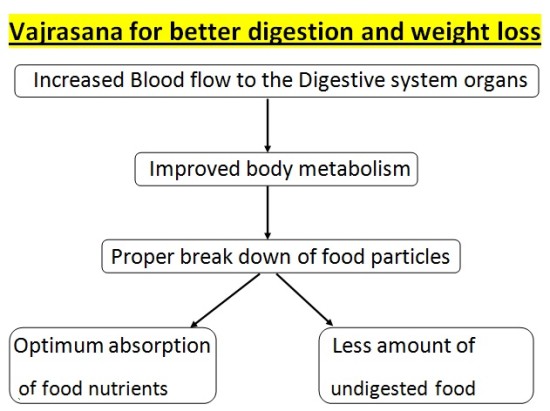
Vajrasana after Meals to improve Digestion
Vajrasana is a beginner’s level yoga posture. Various yoga experts across the world advice to sit in vajrasana after meals to improve digestion.
During the Japanese Tea Ceremony, people sit in Vajrasana. The Namaz pose, used by Muslims for prayer also resembles to Vajrasana.
When you sit in vajrasana, blood flow to the organs of digestive system increases to improve their functioning. Regular practice of vajrasana after meals can bring significant improvement in various digestive tract related issues such as:
- Constipation
- Indigestion
- Gas and bloating
- Hyper-acidity and heartburn
- Hemorrhoids (piles)
According to Swami Ramdev, famous yoga guru in India, people suffering from weak digestion and liver related problems should sit in Vajrasana after meals for 15 minutes for relief.
What is Vajrasana
- Vajra is a Sanskrit word which means thunderbolt
- Asana means body posture
Apart from improving the digestion, vajrasana provides strength to the muscles of legs, hips and lower back to make your body firm and strong.
Other names of Vajrasana are:
- The Thunderbolt pose
- The Diamond pose
- The Adamantine pose which is derived from the word “adamant”
How to do Vajrasana
- Kneel down on a yoga mat and gently stretch the lower legs. Both the knees and big toes should touch each other.
- Slowly rest your buttocks in between the heels. The thighs would be resting on the calves.
- Slowly rest the palm of your hands on the knees.
- Keep the spine straight and close your eyes.
- Concentrate on the breathing- inhalation (breathing in) and exhalation (breathing out).
- Breathe normally without putting any strain.
- People with flexible body would find vajrasana quite easy. Others may experience some pain during first few sessions.
- If you feel too much pain, undo the posture and stretch your legs. Gently massage the toes, ankles and calf muscles. Then, sit again in Vajrasana.
- To subside the pain during initial few sittings, you may use a cushion below the feet.
- Gradually your body’s flexibility would increase and sitting in vajrasana would become comfortable for you.
Video tutorial (in English)- Click here
Video tutorial (in Hindi)- Click here
How long to sit in Vajrasana
Sit for a minimum of 2 minutes during initial few sessions. Then, slowly increase the time per sitting as per your comfort. For optimum results, practice vajrasana after the meals for 15 minutes.
Vajrasana after Meals to improve Digestion
Vajrasana is the only yoga exercise which can be practiced after the meals. Otherwise, yoga and pranayam exercises are meant to be performed before the meals, preferably on an empty stomach.
During Vajrasana, blood flow decreases towards the lower part of the body (legs and thighs) and increases towards the pelvic area (small intestine, large intestine and the reproductive organs). It would result in better functioning of the digestive and reproductive system of the body.
Pelvic region of the body is referred to the lower abdomen. It contains digestive and reproductive organs.
Practicing vajrasana for 15 minutes after the meals is a good alternative to the walking exercise. Hence, if you hate going for a long walk after the meals, just sit in vajrasana and watch your favorite TV program.
Important points to consider
- For best results, sit in vajrasana immediately after the meals. If you are unable to practice vajrasana after breakfast and lunch due to busy schedule, practice it after the dinner at least.
- Sit in vajrasana immediately (within a few minutes) after the meals. Don’t delay too much.
Health Benefits of Vajrasana after the meals
- Improved Digestion– This is the most talked about benefit of vajrasana.
- Aids in weight loss- Sitting in vajrasana stimulates the body metabolism to break down food particles, particularly the fats. It results in less accumulation of body fat to get a flat belly.
- Preventive measure for arthritis and joint pain– If you have a family history of arthritis, then practice vajrasana regularly. It increases the flexibility of knee joints and ankles to prevent any possible attack of arthritis.
- Relief in skin disorders– The root cause of many skin diseases lies in the gut (stomach). By improving the digestion, you are accumulating less toxins (undigested food) in your gut. A clear, toxin free gut would result in healthy, glowing skin.
Read more: Anulom Vilom pranayam for Skin care
- Healthy reproductive system- As explained above, not only the digestive system- vajrasana improves blood flow to the reproductive organs as well. It gives them strength and improve their functioning. This posture is advised by yoga experts to treat urinary disorders, erectile dysfunction and sometimes, menstrual problems as well.
- Muscles toning- Longer sittings (more than 20 minutes) in vajrasana can help tone up the body muscles of thighs, hips and calves.
- Muscles relaxation– During Vajrasana, the muscles and nerves of your ankles, feel, and legs are stretched and relaxed. If the restless legs are giving you sleepless nights, then sitting in vajrasana after dinner would help you enjoy trouble free sleep.
Vajrasana and Meditation
When you sit in Vajrasana, you are witnessing a straighten spine with slow, rhythmic breathing without much efforts. It is an ideal posture for meditation. Numerous yoga teachers and spiritual gurus prefer to sit in vajrasana for longer meditation sessions.
Vajrasana and Kapalbhati together
For enhanced health benefits, a lot of people prefer to practice Kapalbhati pranayam in vajrasana pose. It can bring amazing results to treat chronic constipation. Similarly, other pranayam exercises can also be performed in the vajrasana posture for additional benefits.
Safety Precautions
In general, people of all ages can practice vajrasana without any problem. It is an entry level yoga posture, quite easy to perform.
But, if you are dealing with any of the below health conditions, better you avoid it:
- Chronic arthritis, gout and joint pain
- Any injury or surgery related to knee and leg
- Slip disc related issues
- Hernia
If you are suffering from stomach ulcer or diseases related to small and big intestine, consult a yoga expert before practicing vajrasana.
Vajrasana during Pregnancy
During the first trimester (initial three months) of pregnancy, vajrasana can be practiced by keeping the knees slightly apart to avoid excessive force on the abdomen.
Similarly, during menstrual periods, sit in vajrasana with knees apart.
All said and done, pregnancy and menstruation are critical conditions and Yoga teacher’s supervision is highly recommended.
References
https://en.wikipedia.org/wiki/Vajrasana_(yoga)
http://www.siddhayogapeeth.com/basic_yogasana_html.php
Image credit- www.amarujala.com




